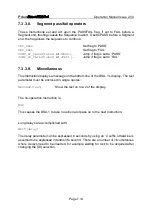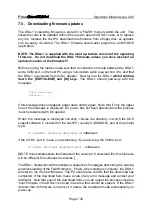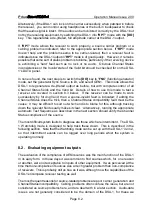
Prism
Operation Manual Issue 2.00
Page 7.23
Two example macro files (EXAMPLE1.MAC and EXAMPLE2.MAC) are loaded into the
MS-DOS installation directory along with the DSAMAC.EXE program. These show
some typical Macro Processor techniques.
7.4.2.3.
Keyword reference
The following is a list of all available Keywords and their actions:
7.4.2.3.1. DSA-1 key presses
These Keywords cause the DSA-1 to react as if the corresponding key had been
pressed. This allows the user to navigate the menu system of the DSA-1 and to vary
the key-controlled operating modes.
LEFT
or
L
'presses' the DSA-1 [<] key
RIGHT
or
R
'presses' the DSA-1 [>] key
ENTER
or
NEXT
'presses' the DSA-1 [ENTER/NEXT] key
EXIT
'presses' the DSA-1 [EXIT] key
EDIT
or
CLEAR
'presses' the DSA-1 [EDIT/CLEAR] key
SPKON
'presses' the DSA-1 [L.S. ON] key
SPKMODE
'presses' the DSA-1 [L.S.MODE] key
VOLUP
or
+
'presses' the DSA-1 [
YY
] key
VOLDOWN
or
-
'presses' the DSA-1 [
ZZ
] key
DIGI
or
DI
'presses' the DSA-1 [DI] key
TERM
'presses' the DSA-1 [TERM] key
CHAN
'presses' the DSA-1 [CHAN] key
DIGO
or
DO
'presses' the DSA-1 [DO] key
SYNC
or
SYNC_OP
'presses' the DSA-1 [SYNC O/P] key
HOME
performs enough
EXIT
s to get to the top level of the menu
system
7.4.2.3.2. Stores - reading the DSA-1 display
The Macro may need to obtain data from the DSA-1's display, for example to display
or file a reading, or to range-check it. The Macro Processor has three stores for this
purpose which are loaded using the following Keywords; the stores can be accessed
by other Keywords for checking or displaying the stored data. The user can specify
exactly where on the DSA-1's screen the data is to be read from, using a coordinate
system: the top row is numbered 1, the bottom row 2, and the columns from 1 to 16 (left
to right).















































